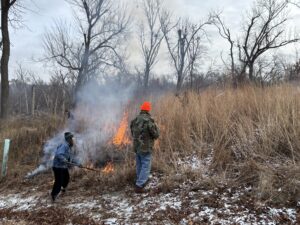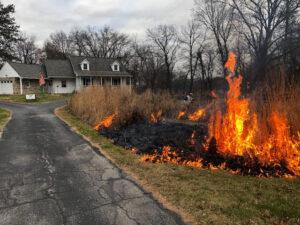Humidity makes a huge difference when it comes to fire. So does the wind.
On mid-morning December 3, 2024, two Cedar Rapids Gazette reporters and a photographer arrived at Winding Pathways to experience a prairie burn. We’d set the date ahead of time, hoping burn conditions would be ideal. They weren’t, but we decided to give it a try.
The humidity was around 75% with barely a puff of breeze.
We aimed to burn our backyard prairie to reduce brush and encourage next year’s wildflowers. With low humidity cured prairie grass burns almost explosively, sending flames towering above the ground.
On the high-humidity morning, we struck a match and started an unenthusiastic fire that crept along the ground and only burned hot a few times. Then it died all by itself. We called it a day.
- Olivia and Rich
- Learning to pull fire.
- Photographer filming
Three days later we tried again under very different conditions. The humidity was down to about 40% and a pleasant and steady southwest wind blew at around 10 miles an hour. What a difference! The fire roared across our prairie, consuming grass it had ignored three days earlier. Marion lit the prairie around her labyrinth and it also roared.
- Low humidity burn
- Fall burns allow forbs to grow.
Dry grass is especially sensitive to changes in humidity. When humidity rises grass quickly absorbs the dampness. When humidity drops, grass sheds moisture just as quickly and is ripe to burn. Wood does the same thing but much slower.
Our burning is now over for the year. We know it will stimulate an amazing array of colors next midsummer when wildflowers are in full bloom.
- Colorful Flowers
- Colorful flowers line the path.
- Prairie grasses capture moisture.









